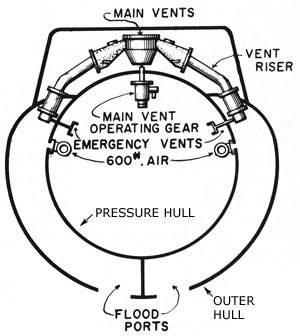Design and ConstructionA World War II submarine is made up of three main components: the inner hull, the outer hull, and the superstructure. The inner hull is the is called the pressure hull and is basically a long cylinder with torpedo tubes protruding from each end. Carried inside this tube are the crew, machinery, and necessary supplies. The outer hull forms the skin upon which the submarine floats when on the surface. The superstructure sits on top of the hulls above the waterline when the boat is at normal surface trim. The superstructure is free-flooding and draining through a series of cut-outs in the superstructure called limber holes. The superstructure forms the pointed bow, the tapered stern and the main deck of the submarine.
The conning tower is a separate cylindrical tank eight feet in diameter and 17 feet long. It sits atop the pressure hull amidships and is accessed through hatches from below and topside. The conning tower is made of thicker forty-pound HTS for added ballistic protection. The "boat shape" of the submarine is formed by the free-flooding superstructure made of lighter gauge steel that is riveted to welded frames. The superstructure forms the main deck, the rising bow and stem, and the rounded tapering stern. The main deck is perforated with small holes and the sides of the superstructure have limber holes cut out to allow the superstructure to be free-flooding during diving and surfacing operations. Portions of the main deck are made up of teak wood slats that are through-bolted to the frames. A superstructure also fares off the area around the torpedo tube muzzle doors, both fore and aft. The only portion of the superstructure that is not free-flooding is the bow buoyancy tank, which held a bubble at the bow for surface operations. The conning tower is enclosed in a free-flooding superstructure that is attached to the main superstructure and forms the bridge and decks for the anti-aircraft guns. The housings for the two periscopes extend above the conning tower and below the conning tower, through the pressure hull to the keel at frames 52-55. Return to the Pampanito Technology page
|

 USS
Pampanito has a cylindrical all-welded pressure hull made of thirty-five
pound (approx. 7/8") high-tensile steel (HTS) and is divided in to 8 compartments
separated by pressure bulkheads with watertight doors. There are 137 frames
numbered from the bow to the stern that strengthen the hull and serve as
reference points. A double hull extends from frame 35 aft to frame 107.
The outer hull is made of 3/8" mild steel and the space between the hulls
is bulkheaded and used for fuel and water ballast. Torpedo rooms, located
at each end of the vessel, are located in the single hull sections of the
submarine. Frame spacing is 30" along the double hull sections, and 24"
along the single hull section. Beyond the torpedo rooms at each end of
the submarine are trim tanks that form the ends of the pressure hull. The
torpedo tubes penetrate the end caps at each end of the cylindrical pressure
hull.
USS
Pampanito has a cylindrical all-welded pressure hull made of thirty-five
pound (approx. 7/8") high-tensile steel (HTS) and is divided in to 8 compartments
separated by pressure bulkheads with watertight doors. There are 137 frames
numbered from the bow to the stern that strengthen the hull and serve as
reference points. A double hull extends from frame 35 aft to frame 107.
The outer hull is made of 3/8" mild steel and the space between the hulls
is bulkheaded and used for fuel and water ballast. Torpedo rooms, located
at each end of the vessel, are located in the single hull sections of the
submarine. Frame spacing is 30" along the double hull sections, and 24"
along the single hull section. Beyond the torpedo rooms at each end of
the submarine are trim tanks that form the ends of the pressure hull. The
torpedo tubes penetrate the end caps at each end of the cylindrical pressure
hull.